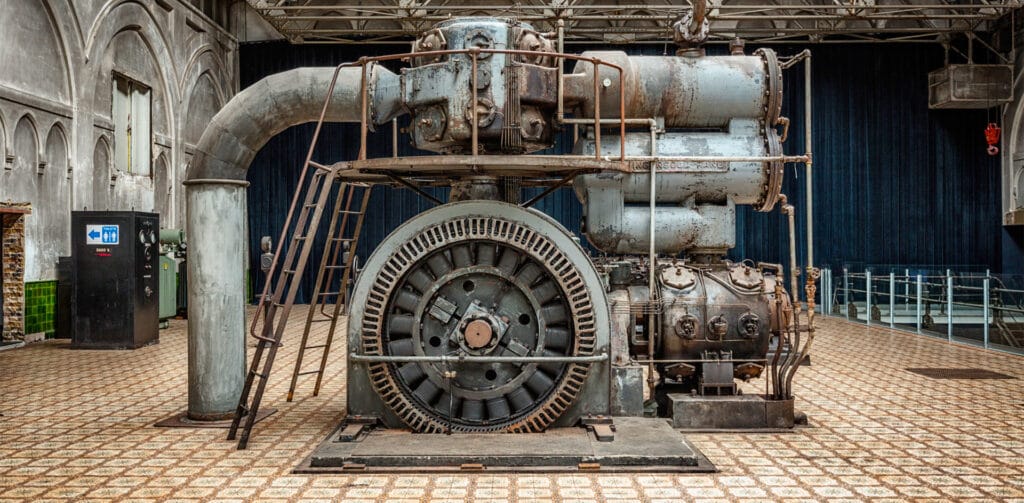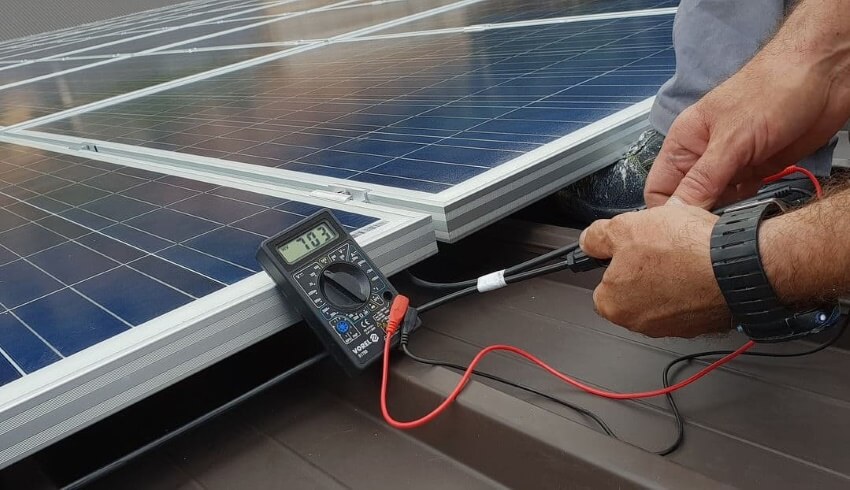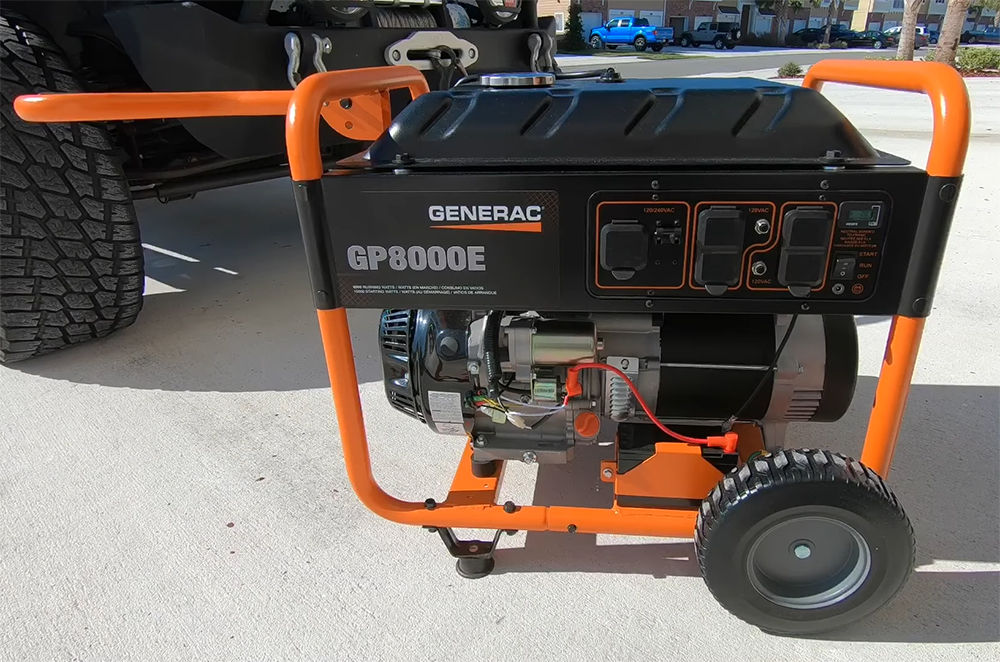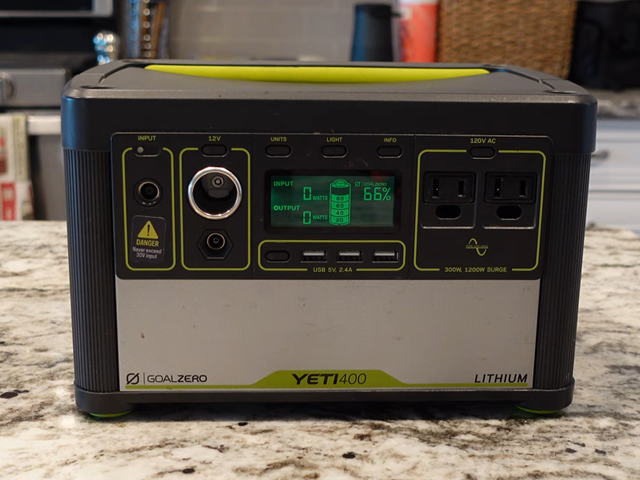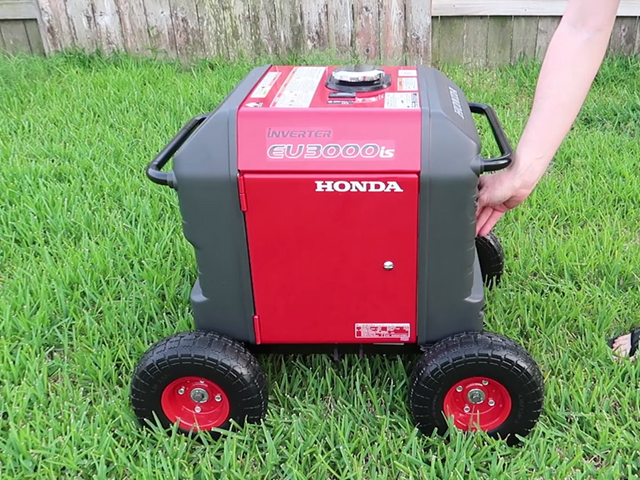
Working effectively on a job site requires power tools. Which means you need a reliable source of power. The best generator for a job site has enough power to meet all of your electrical demands and a gas tank large enough to run all day.
We looked at dozens of generators in order to find the 6 best options for contractors and professionals. The DEWALT DXGN7000 stood out from all the alternatives. There was a lot to think about in our review, but the most important consideration was the surge and continuous power each generator could put out. ON top of that, we looked for engine reliability, run times that were long enough to power you through an entire work day, plenty of outlets to suit different tool requirements, and GFCI protection to keep you safe.
This inexpensive DEWALT generator is a good choice for a wide variety of work sites. The 8,750 watts of surge power is a little on the low side, but contractors appreciated having fully 7,000 watts of running power. On top of that, you can run this generator at around 4,000 watts and still get in a full day of power.
The main limitation to this generator is the outlet panel. There are two 120-volt duplex outlets, but only a single 30-amp twist-lock outlet. That’s pretty limiting on the number of tools you can plug in at once, especially if you rely on heavy-duty 30-amp tools. Worse, none of the outlets are backed up by a GFCI circuit.
Still, users were largely happy with the DEWALT generator because it’s so simple to use. It has both electric and recoil start options, and an idle control switch allows you to conserve fuel and reduce noise when your tools aren’t drawing power. On top of that, the outlet panel has a small LED display that shows run time, power draw, and voltage.
Contractors also found that the generator is extremely reliable over the long term, even with everyday use. It comes with a three-year commercial warranty, and Dewalt’s customer service team has a reputation for being extremely helpful when things to go wrong.
One additional minor downside to watch out for with this generator is portability. The steel frame and pneumatic wheels help, but there’s no tow point on the top of the generator to help you lift it.
If you need surge power over any other features, this generator from Westinghouse is for you. It boasts a whopping 11,500 watts of surge power, plus 8,500 watts of continuous power to keep your tools running. It can also put out a pretty impressive amount of power throughout the whole day – it’s rated for 4,250 watts for 12 hours, or upwards of 5,000 watts for eight hours.
The outlet panel is fully backed by a GFCI circuit, which is a major advantage for this generator at worksites that need to comply with OSHA standards. The outlet selection is similar to the Yamaha generator – four 120-volt, 20-amp outlets and two 30-amp outlets, with one capable of toggling between 120- and 240-volt output. There’s also a DC outlet on this generator for battery charging. All in all, you can use this generator with an extremely wide assortment of power tools, and contractors were very happy with this setup.
In addition, there are a few features for ease of use. Westinghouse included an LED data center, and the generator can be started with an electric switch or a backup recoil cord. You can even start this generator remotely using an included key fob.
As you’d expect, this generator is hefty. However, users were happy to find a tow hook bracket on the top of the unit as well as never-flat wheels for moving it around.
The only big thing to watch out for is that Westinghouse limits the warranty on this generator to just one year for commercial users.
The Honda EB10000 made it to our list thanks to its massive array of features. To start, this generator is incredibly powerful. It’s capable of producing 10,000 watts of surge power or 9,000 continuous watts, so it’s ideal for large job sites with a lot of heavy tools in use. On top of that, Honda is known for making extraordinarily reliable engines, so you can depend on this generator for years to come.
What really sets this generator apart is the outlet panel. There are four 125-volt outlets, two 30-amp locking outlets, and a 50-amp locking outlet. All of the outlets, including the high amperage outlets, are backed by a GFCI circuit for safety. Better yet, you can operate the locking outlets at 250 volts while still using the 125-volt outlets.
The run time on this generator is slightly on the low side, at just 7.5 hours at a 50% load. That means you can get a full day of use out of the EB10000, but only if you limit yourself to 4,500 watts. Given the high cost of this generator, that’s a bit of a letdown.
In addition, this generator weighs nearly twice as much as most of the other job site generators we looked at. It has heavy-duty wheels and a crane lift point for portability, but figuring out how to move a 400-pound generator is a challenge unto itself.
Finally, while the generator comes with an electric starter, there’s no recoil backup. So, you have to be vigilant about keeping the onboard battery charged.
This Yamaha generator isn’t the most powerful job site generator we looked at, but that can be an advantage if you don’t need more than 7,200 surge watts. Users found that this generator is noticeably quieter than some of the larger models, and thanks to a highly efficient engine it can put out even more power – 6,000 running watts – for a full day of work. That’s a huge advantage, since balancing run time and power is the biggest issue that contractors have with many professional generators.
On top of that, this generator has a well-equipped outlet panel. In addition to four 120-volt outlets, there are two 30-amp outlets and one of them can be toggled between 120- and 240-volt power. You can use 240-volt output while still running at 120 volts across the rest of the outlet panel as well. Even better, the duplex outlets are backed by a GFCI circuit (although the 30-amp outlets are not).
The generator is outfitted with both electric and recoil starters, so you have convenience and a backup if you need it. There’s also a digital hour meter that shows remaining run time, wattage draw, and voltage output.
This generator is surprisingly heavy for its size, but users liked the adaptations that Yamaha made to help with portability. There’s a tow handle on the top of the unit, plus pneumatic never-flat wheels. The entire generator is surrounded by a steel roll cage for protection.
This moderately priced job site generator from Cat has a lot to offer. It’s not the most powerful generator on the market, but with 9,375 watts of surge power and 7,500 watts of running power it can handle most contractors’ requirements. It would be nice to see a slightly larger fuel tank on the generator, since you’re limited to about 4,000 watts if you want to make it through an eight-hour workday.
The outlet panel is well-equipped with a pair of 120-volt duplex outlets and two 30-amp twist-lock outlets. The 120-volt outlets are backed by a GFCI circuit, but note that the heavier-duty twist-lock outlets are not. There’s also a small display that shows power draw, remaining run time, and voltage output, which is helpful for keeping an eye on the generator’s performance.
This generator is surprisingly compact and lightweight for the amount of power it puts out. On top of that, an electric start function makes it easier to use and there’s a recoil starter as a backup if you ever need it. Users were also happy to find that it has a fuel drainage shutoff, which will run the carburetor dry so you can store the generator without fuel going stale inside.
One minor issue that users noted is that the wheels are made of plastic and are not pneumatic. They didn’t report any breaks, but plastic components on a generator this size are typically the first thing to go.
This inexpensive generator from Generac offers almost as much power as the Honda model, but at roughly one-fifth the cost. That makes it an extremely attractive alternative to power-hungry contractors on a tight budget. The running power is slightly lower, at 8,000 watts, but the larger fuel tank means that you can run this generator at roughly the same power as the Honda and still get a full day of power.
However, it’s important to note that this generator lacks a 50-amp outlet. Instead, you get a pair of 120-volt duplex outlets, a single 30-amp twist-lock outlet, and a 12-volt DC outlet. Having only one 30-amp outlet can limit your options for plugging in heavy-duty tools, although most contractors didn’t seem to mind this for smaller job sites. In addition, bear in mind that none of the outlets are backed by GFCI circuits for safety.
The generator offers both electric and recoil starters, which is nice. Users also appreciated that the onboard battery could be manually charged via the DC outlet. There is a display that indicates how much wattage you’re drawing from the generator, but it’s a scale bar rather than a number. Users noted this wasn’t quite as helpful as a more traditional data display screen.
The other thing to watch out for with this generator is the short warranty. Generac only issues a one-year warranty for commercial users, which means you’re taking on a bit more risk than with other models we reviewed. Still, complaints of issues with this generator from contractors were extremely rare.
Now that you’ve learned more about our six favorite generators for a job site, how do you choose which one is right for your needs? A professional generator has to satisfy a lot of competing demands. Our guide will walk you through everything you need to know in order to get the perfect generator for you.
Professional use generators aren’t cheap. So, do you really need a commercial-ready generator rather than an inexpensive consumer generator?
The short answer is yes. Generators for professional use are built to handle a lot more use than your average consumer generator. While a homeowner may only run their unit a few times per year, a job site generator is going to be worked day in and day out for hours at a time. That puts a lot of strain on your generator’s engine, and professional use generators are built to handle that demand.
On top of that, professional use generators come with a number of features that can dramatically increase productivity and safety on a job site.
Many are built with large fuel tanks so that they can run at a 50% load or full load for a full day. That means you don’t have to waste time in the middle of your work powering the generator down and cooling it off for refueling.
Job site generators also come with a variety of outlets beyond the standard 120-volt duplex. Most of the generators we reviewed are capable of outputting 240-volt power to support energy-hungry tools, and there are typically multiple 30-amp twist-lock outlets that you can take advantage of. Professional generators also put an emphasis on electrical safety, backing outlets with GFCI circuits to prevent dangerous power surges.
There are a lot of options when it comes to choosing the best job site generator for your work. Here, we’ll review some of the features you need to think about when deciding which model is right for you.
The engine is at the heart of every generator, and it’s the component that will take the brunt of the wear and tear from everyday use. So, it’s extremely important that your generator’s engine is reliable and durable.
All of the generators we reviewed are from companies with excellent reputations for engine construction and lifespan. We vetted these models to ensure that users haven’t experienced any issues with engine degradation over several years of professional use. Of course, it’s important to ensure that you properly maintain your generator’s engine with oil and filter changes to get the most life out of your generator.
If you’re working on a job site, time without power is lost productivity and lost money. So, it’s important to look for a contractor generator that can go all day without a refueling stop. Of the generators we reviewed, only the Yamaha model offers a full eight hours of run time at its rated 6,000-watt load. However, all of the other generators we looked at offered at least 7.5 hours at a 50% load, and some can run at greater than 6,000 watts for a full day.
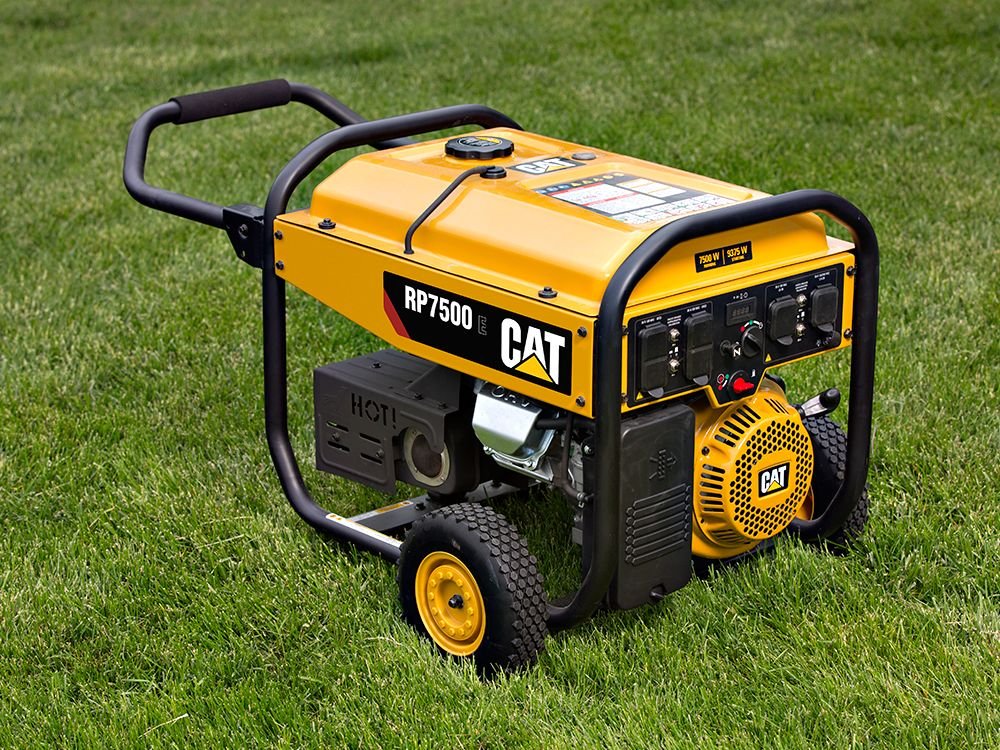
A very useful safety feature to look for is GFCI circuit backing on all outlets. This is available on the Honda EB10000, and it ensures that you don’t have to worry about an electrical surge damaging your tools or electrocuting one of your workers. Many of the other generators we reviewed, including the Yamaha, Generac, and Cat models, only offer GFCI protection on 120-volt duplex outlets.
While problems with the generators we reviewed are rare, it’s nice to know that your expensive generator is protected in case something goes wrong. Many companies offer three-year warranties on their generators, even if you use it for a commercial application like powering a job site. However, beware that some companies, like Westinghouse and Generac, reduce their warranties to just one year for commercial operators.
It’s also a good idea to ensure that the company behind your generator has a helpful customer service team in place. You can even give the customer support line a call before investing in a generator, just to make sure they’ll be there if you need them in the future.
Powerful commercial generators aren’t lightweight. Most of the models we looked at weigh over 200 pounds. But, that doesn’t mean that you shouldn’t think about portability. Even if you leave your generator at a job site for weeks on end, you’ll have to move it between sites sooner or later. When that time comes, having sturdy pneumatic wheels and a steel frame is extremely helpful. In addition, look for metal plates that you can hook a tow lift into, like on the Westinghouse, Yamaha, and Honda generators.
Generators are largely easy to use, but there are a few features that can improve the experience. The most important of these is an electronic starting system, which saves you the pain of cranking on a recoil starter to get your generator’s engine going. All of the generators we reviewed feature an electric starting system, and many have a recoil cable as a backup.
Another helpful tool is a display panel or analog voltmeter so that you can monitor how much power you are drawing from your generator. An electronic display panel also shows remaining run time, which can be helpful if you’re considering plugging in one more tool as the fuel tank is running low.
Finally, adding fuel and oil should be easy. This is the case on all of the generators we reviewed, but it’s important to check the process if you look at other generator models.
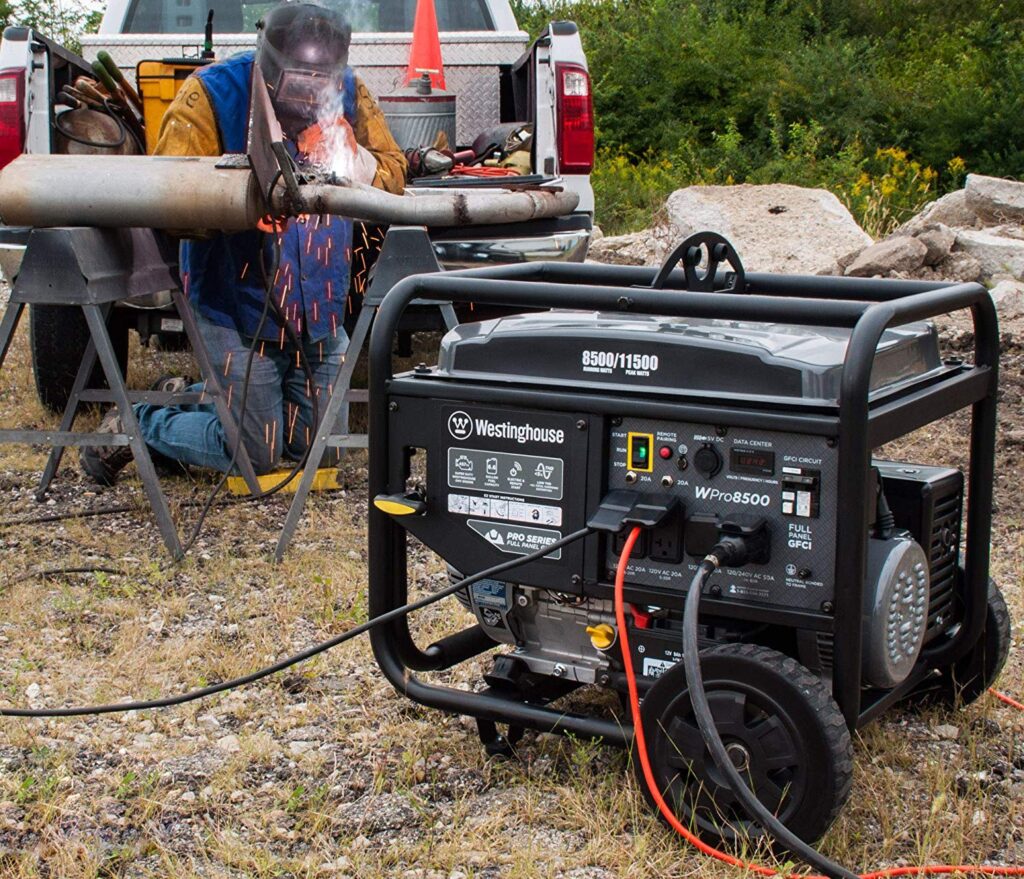
Most of the job site generators that we reviewed cost between $1,000 and $1,500. However, you will pay a premium for brand names like Yamaha and Honda. The Yamaha EF7200DE costs $2,000 despite putting out less power than the other models we reviewed, while the Honda EB10000 costs nearly $5,500.
Our overall favorite generator for a job site is the DEWALT DXGN7000. We feel it is the overall best generator for a job site because it is small, but mighty. It also comes with a handy small LED display showing power draw, remaining run time, and voltage output.
